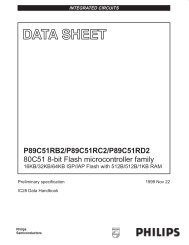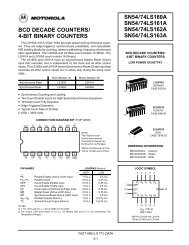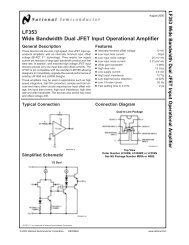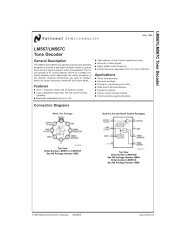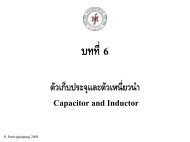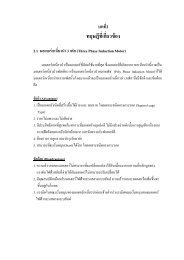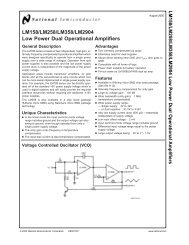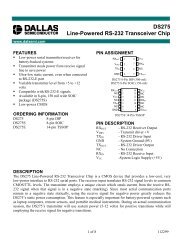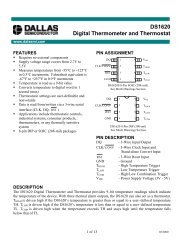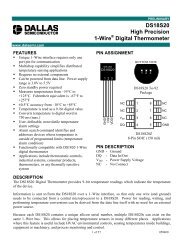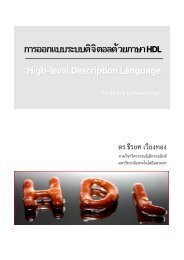ICL7106, ICL7107, ICL7106S, ICL7107S - Electronics Lab
ICL7106, ICL7107, ICL7106S, ICL7107S - Electronics Lab
ICL7106, ICL7107, ICL7106S, ICL7107S - Electronics Lab
Create successful ePaper yourself
Turn your PDF publications into a flip-book with our unique Google optimized e-Paper software.
January 1998<br />
<strong>ICL7106</strong>, <strong>ICL7107</strong>,<br />
<strong>ICL7106</strong>S, <strong>ICL7107</strong>S<br />
3 1 / 2 Digit,<br />
LCD/LED Display, A/D Converters<br />
Features<br />
• Guaranteed Zero Reading for 0V Input on All Scales<br />
• True Polarity at Zero for Precise Null Detection<br />
• 1pA Typical Input Current<br />
• True Differential Input and Reference, Direct Display Drive<br />
- LCD <strong>ICL7106</strong>, LED lCL7107<br />
• Low Noise - Less Than 15µV P-P<br />
• On Chip Clock and Reference<br />
• Low Power Dissipation - Typically Less Than 10mW<br />
• No Additional Active Circuits Required<br />
• Enhanced Display Stability (<strong>ICL7106</strong>S, <strong>ICL7107</strong>S)<br />
Ordering Information<br />
PART NO.<br />
TEMP.<br />
RANGE ( o C) PACKAGE PKG. NO.<br />
Description<br />
The Intersil <strong>ICL7106</strong> and <strong>ICL7107</strong> are high performance, low<br />
power, 3 1 / 2 digit A/D converters. Included are seven segment<br />
decoders, display drivers, a reference, and a clock.<br />
The <strong>ICL7106</strong> is designed to interface with a liquid crystal display<br />
(LCD) and includes a multiplexed backplane drive; the<br />
<strong>ICL7107</strong> will directly drive an instrument size light emitting<br />
diode (LED) display.<br />
The <strong>ICL7106</strong> and <strong>ICL7107</strong> bring together a combination of<br />
high accuracy, versatility, and true economy. It features autozero<br />
to less than 10µV, zero drift of less than 1µV/ o C, input<br />
bias current of 10pA (Max), and rollover error of less than<br />
one count. True differential inputs and reference are useful in<br />
all systems, but give the designer an uncommon advantage<br />
when measuring load cells, strain gauges and other bridge<br />
type transducers. Finally, the true economy of single power<br />
supply operation (<strong>ICL7106</strong>), enables a high performance<br />
panel meter to be built with the addition of only 10 passive<br />
components and a display.<br />
<strong>ICL7106</strong>CPL 0 to 70 40 Ld PDIP E40.6<br />
<strong>ICL7106</strong>RCPL 0 to 70 40 Ld PDIP (Note) E40.6<br />
<strong>ICL7106</strong>CM44 0 to 70 44 Ld MQFP Q44.10x10<br />
<strong>ICL7106</strong>SCPL 0 to 70 40 Ld PDIP E40.6<br />
<strong>ICL7107</strong>SCPL 0 to 70 40 Ld PDIP E40.6<br />
<strong>ICL7107</strong>CPL 0 to 70 40 Ld PDIP E40.6<br />
<strong>ICL7107</strong>RCPL 0 to 70 40 Ld PDIP (Note) E40.6<br />
<strong>ICL7107</strong>CM44 0 to 70 44 Ld MQFP Q44.10x10<br />
NOTE: “R” indicates device with reversed leads for mounting to PC<br />
board underside. “S” indicates enhanced stability.<br />
CAUTION: These devices are sensitive to electrostatic discharge. Users should follow proper IC Handling Procedures.<br />
http://www.intersil.com or 407-727-9207 | Copyright © Intersil Corporation 1999<br />
1<br />
File Number 3082.2
<strong>ICL7106</strong>, <strong>ICL7107</strong>, <strong>ICL7106</strong>S, <strong>ICL7107</strong>S<br />
Pinouts<br />
<strong>ICL7106</strong>, <strong>ICL7107</strong> (PDIP)<br />
TOP VIEW<br />
<strong>ICL7106</strong>R, <strong>ICL7107</strong>R (PDIP)<br />
TOP VIEW<br />
V+<br />
1<br />
40<br />
OSC 1<br />
OSC 1<br />
1<br />
40<br />
V+<br />
D1<br />
2<br />
39<br />
OSC 2<br />
OSC 2<br />
2<br />
39<br />
D1<br />
C1<br />
3<br />
38<br />
OSC 3<br />
OSC 3<br />
3<br />
38<br />
C1<br />
B1<br />
4<br />
37<br />
TEST<br />
TEST<br />
4<br />
37<br />
B1<br />
(1’s)<br />
A1<br />
5<br />
36<br />
REF HI<br />
REF HI<br />
5<br />
36<br />
A1<br />
(1’s)<br />
F1<br />
6<br />
35<br />
REF LO<br />
REF LO<br />
6<br />
35<br />
F1<br />
G1<br />
7<br />
34<br />
C REF +<br />
C REF +<br />
7<br />
34<br />
G1<br />
E1<br />
8<br />
33<br />
C REF -<br />
C REF -<br />
8<br />
33<br />
E1<br />
D2<br />
9<br />
32<br />
COMMON<br />
COMMON<br />
9<br />
32<br />
D2<br />
C2<br />
10<br />
31<br />
IN HI<br />
IN HI<br />
10<br />
31<br />
C2<br />
(10’s)<br />
B2<br />
A2<br />
11<br />
12<br />
30<br />
29<br />
IN LO<br />
A-Z<br />
IN LO<br />
A-Z<br />
11<br />
12<br />
30<br />
29<br />
B2<br />
A2<br />
(10’s)<br />
F2<br />
13<br />
28<br />
BUFF<br />
BUFF<br />
13<br />
28<br />
F2<br />
E2<br />
14<br />
27<br />
INT<br />
INT<br />
14<br />
27<br />
E2<br />
D3<br />
15<br />
26<br />
V-<br />
V-<br />
15<br />
26<br />
D3<br />
(100’s)<br />
B3<br />
F3<br />
E3<br />
16<br />
17<br />
18<br />
25<br />
24<br />
23<br />
G2 (10’s)<br />
C3<br />
A3 (100’s)<br />
G2 (10’s)<br />
C3<br />
(100’s) A3<br />
16<br />
17<br />
18<br />
25<br />
24<br />
23<br />
B3<br />
F3<br />
E3<br />
(100’s)<br />
(1000) AB4<br />
19<br />
22<br />
G3<br />
G3<br />
19<br />
22<br />
(1000) AB4<br />
(MINUS)<br />
POL<br />
20<br />
21<br />
BP/GND<br />
BP/GND<br />
20<br />
21<br />
POL<br />
(MINUS)<br />
<strong>ICL7106</strong>, <strong>ICL7107</strong> (MQFP)<br />
TOP VIEW<br />
REF HI<br />
REF LO<br />
C REF +<br />
C REF -<br />
COMMON<br />
IN HI<br />
IN LO<br />
A-Z<br />
BUFF<br />
INT<br />
V-<br />
NC<br />
44 43 42 41 40<br />
1<br />
39 38 37 36 35 34<br />
33<br />
NC<br />
TEST<br />
OSC 3<br />
NC<br />
OSC 2<br />
OSC 1<br />
V+<br />
D1<br />
C1<br />
2<br />
3<br />
4<br />
5<br />
6<br />
7<br />
8<br />
9<br />
10<br />
32<br />
31<br />
30<br />
29<br />
28<br />
27<br />
26<br />
25<br />
24<br />
B1 11<br />
12 13 14 15 16 17 18 19<br />
23<br />
20 21 22<br />
NC<br />
G2<br />
C3<br />
A3<br />
G3<br />
BP/GND<br />
POL<br />
AB4<br />
E3<br />
F3<br />
B3<br />
A1 F1 G1 E1 D2 C2 B2 A2 F2 E2 D3<br />
2
<strong>ICL7106</strong>, <strong>ICL7107</strong>, <strong>ICL7106</strong>S, <strong>ICL7107</strong>S<br />
Absolute Maximum Ratings<br />
Supply Voltage<br />
<strong>ICL7106</strong>, V+ to V- . . . . . . . . . . . . . . . . . . . . . . . . . . . . . . . . . . 15V<br />
<strong>ICL7107</strong>, V+ to GND. . . . . . . . . . . . . . . . . . . . . . . . . . . . . . . . . 6V<br />
<strong>ICL7107</strong>, V- to GND . . . . . . . . . . . . . . . . . . . . . . . . . . . . . . . . .-9V<br />
Analog Input Voltage (Either Input) (Note 1). . . . . . . . . . . . . V+ to V-<br />
Reference Input Voltage (Either Input) . . . . . . . . . . . . . . . . . V+ to V-<br />
Clock Input<br />
<strong>ICL7106</strong> . . . . . . . . . . . . . . . . . . . . . . . . . . . . . . . . . . . TEST to V+<br />
<strong>ICL7107</strong> . . . . . . . . . . . . . . . . . . . . . . . . . . . . . . . . . . . .GND to V+<br />
Operating Conditions<br />
Temperature Range . . . . . . . . . . . . . . . . . . . . . . . . . . . .0 o C to 70 o C<br />
Thermal Information<br />
Thermal Resistance (Typical, Note 2)<br />
θ JA ( o C/W)<br />
PDIP Package . . . . . . . . . . . . . . . . . . . . . . . . . . . . . . . 50<br />
MQFP Package . . . . . . . . . . . . . . . . . . . . . . . . . . . . . . 80<br />
Maximum Junction Temperature . . . . . . . . . . . . . . . . . . . . . . . 150 o C<br />
Maximum Storage Temperature Range . . . . . . . . . .-65 o C to 150 o C<br />
Maximum Lead Temperature (Soldering 10s) . . . . . . . . . . . . . 300 o C<br />
(MQFP - Lead Tips Only)<br />
CAUTION: Stresses above those listed in “Absolute Maximum Ratings” may cause permanent damage to the device. This is a stress only rating and operation<br />
of the device at these or any other conditions above those indicated in the operational sections of this specification is not implied.<br />
NOTES:<br />
1. Input voltages may exceed the supply voltages provided the input current is limited to ±100µA.<br />
2. θ JA is measured with the component mounted on an evaluation PC board in free air.<br />
Electrical Specifications (Note 3)<br />
SYSTEM PERFORMANCE<br />
PARAMETER TEST CONDITIONS MIN TYP MAX UNIT<br />
Zero Input Reading V IN = 0.0V, Full Scale = 200mV -000.0 ±000.0 +000.0 Digital<br />
Reading<br />
Stability (Last Digit) (<strong>ICL7106</strong>S, <strong>ICL7107</strong>S<br />
Only)<br />
Fixed Input Voltage (Note 7) -000.0 ±000.0 +000.0 Digital<br />
Reading<br />
Ratiometric Reading V lN = V REF , V REF = 100mV 999 999/10<br />
00<br />
1000 Digital<br />
Reading<br />
Rollover Error<br />
Linearity<br />
-V IN = +V lN ≅ 200mV<br />
Difference in Reading for Equal Positive and<br />
Negative Inputs Near Full Scale<br />
Full Scale = 200mV or Full Scale = 2V Maximum<br />
Deviation from Best Straight Line Fit (Note 6)<br />
- ±0.2 ±1 Counts<br />
- ±0.2 ±1 Counts<br />
Common Mode Rejection Ratio V CM = 1V, V IN = 0V, Full Scale = 200mV (Note 6) - 50 - µV/V<br />
Noise<br />
V IN = 0V, Full Scale = 200mV<br />
(Peak-To-Peak Value Not Exceeded 95% of Time)<br />
- 15 - µV<br />
Leakage Current Input V lN = 0 (Note 6) - 1 10 pA<br />
Zero Reading Drift V lN = 0, 0 o C To 70 o C (Note 6) - 0.2 1 µV/ o C<br />
Scale Factor Temperature Coefficient V IN = 199mV, 0 o C To 70 o C,<br />
(Ext. Ref. 0ppm/ o C) (Note 6)<br />
- 1 5 ppm/ o C<br />
End Power Supply Character V+ Supply<br />
Current<br />
V IN = 0 (Does Not Include LED Current for <strong>ICL7107</strong>) - 1.0 1.8 mA<br />
End Power Supply Character V- Supply Current <strong>ICL7107</strong> Only - 0.6 1.8 mA<br />
COMMON Pin Analog Common Voltage<br />
Temperature Coefficient of Analog Common<br />
DISPLAY DRIVER <strong>ICL7106</strong> ONLY<br />
25kΩ Between Common and<br />
Positive Supply (With Respect to + Supply)<br />
25kΩ Between Common and<br />
Positive Supply (With Respect to + Supply)<br />
2.4 3.0 3.2 V<br />
- 80 - ppm/ o C<br />
Peak-To-Peak Segment Drive Voltage<br />
Peak-To-Peak Backplane Drive Voltage<br />
V+ = to V- = 9V (Note 5) 4 5.5 6 V<br />
3
<strong>ICL7106</strong>, <strong>ICL7107</strong>, <strong>ICL7106</strong>S, <strong>ICL7107</strong>S<br />
Electrical Specifications<br />
(Note 3) (Continued)<br />
PARAMETER TEST CONDITIONS MIN TYP MAX UNIT<br />
DISPLAY DRIVER <strong>ICL7107</strong> ONLY<br />
Segment Sinking Current<br />
V+ = 5V, Segment Voltage = 3V<br />
(Except Pins 19 and 20) 5 8 - mA<br />
Pin 19 Only 10 16 - mA<br />
Pin 20 Only 4 7 - mA<br />
NOTES:<br />
3. Dissipation rating assumes device is mounted with all leads soldered to printed circuit board.<br />
4. Unless otherwise noted, specifications apply to both the <strong>ICL7106</strong> and <strong>ICL7107</strong> at T A =25 o C, f CLOCK = 48kHz. <strong>ICL7106</strong> is tested in the<br />
circuit of Figure 1. <strong>ICL7107</strong> is tested in the circuit of Figure 2.<br />
5. Back plane drive is in phase with segment drive for ‘off’ segment, 180 degrees out of phase for ‘on’ segment. Frequency is 20 times<br />
conversion rate. Average DC component is less than 50mV.<br />
6. Not tested, guaranteed by design.<br />
7. Sample Tested.<br />
Typical Applications and Test Circuits<br />
R R 1<br />
5<br />
C<br />
R C 5<br />
4 1 C 2 C 3<br />
R 3 C 4<br />
40<br />
39<br />
38<br />
37<br />
36<br />
35<br />
34<br />
33<br />
32<br />
31<br />
30<br />
29<br />
1<br />
2<br />
3<br />
4<br />
5<br />
6<br />
7<br />
8<br />
9<br />
+ -<br />
IN<br />
R 2<br />
9V<br />
28<br />
10<br />
11<br />
12<br />
13<br />
27<br />
26<br />
25<br />
OSC 1<br />
OSC 2<br />
OSC 3<br />
TEST<br />
REF HI<br />
REF LO<br />
C REF +<br />
C REF -<br />
COM<br />
IN HI<br />
IN LO<br />
A-Z<br />
BUFF<br />
INT<br />
V-<br />
G2<br />
<strong>ICL7106</strong><br />
V+<br />
D1<br />
C1<br />
B1<br />
A1<br />
F1<br />
G1<br />
E1<br />
D2<br />
C2<br />
B2<br />
A2<br />
F2<br />
E2<br />
D3<br />
B3<br />
+<br />
-<br />
14<br />
15<br />
16<br />
DISPLAY<br />
24<br />
23<br />
22<br />
C3<br />
A3<br />
G3<br />
F3<br />
E3<br />
AB4<br />
17<br />
18<br />
19<br />
20 POL<br />
BP 21<br />
C 1 = 0.1µF<br />
C 2 = 0.47µF<br />
C 3 = 0.22µF<br />
C 4 = 100pF<br />
C 5 = 0.02µF<br />
R 1 = 24kΩ<br />
R 2 = 47kΩ<br />
R 3 = 100kΩ<br />
R 4 = 1kΩ<br />
R 5 = 1MΩ<br />
DISPLAY<br />
FIGURE 1. <strong>ICL7106</strong> TEST CIRCUIT AND TYPICAL APPLICATION WITH LCD DISPLAY COMPONENTS SELECTED FOR 200mV<br />
FULL SCALE<br />
+5V + -<br />
-5V<br />
IN<br />
R R 1<br />
5<br />
C<br />
R C 5<br />
1 C R 4 2 2 C 3<br />
R 3 C 4<br />
DISPLAY<br />
40<br />
39<br />
38<br />
37<br />
36<br />
35<br />
34<br />
33<br />
32<br />
31<br />
30<br />
29<br />
28<br />
27<br />
26<br />
25<br />
24<br />
23<br />
22<br />
OSC 1<br />
OSC 2<br />
OSC 3<br />
TEST<br />
REF HI<br />
REF LO<br />
C REF +<br />
C REF -<br />
COM<br />
IN HI<br />
IN LO<br />
A-Z<br />
BUFF<br />
INT<br />
V-<br />
G2<br />
C3<br />
A3<br />
G3<br />
<strong>ICL7107</strong><br />
V+<br />
D1<br />
C1<br />
B1<br />
A1<br />
F1<br />
G1<br />
E1<br />
D2<br />
C2<br />
B2<br />
A2<br />
F2<br />
E2<br />
D3<br />
B3<br />
F3<br />
E3<br />
AB4<br />
1<br />
2<br />
3<br />
4<br />
5<br />
6<br />
7<br />
8<br />
9<br />
10<br />
11<br />
12<br />
13<br />
14<br />
15<br />
16<br />
17<br />
18<br />
19<br />
20 POL GND 21<br />
C 1 = 0.1µF<br />
C 2 = 0.47µF<br />
C 3 = 0.22µF<br />
C 4 = 100pF<br />
C 5 = 0.02µF<br />
R 1 = 24kΩ<br />
R 2 = 47kΩ<br />
R 3 = 100kΩ<br />
R 4 = 1kΩ<br />
R 5 = 1MΩ<br />
DISPLAY<br />
FIGURE 2. <strong>ICL7107</strong> TEST CIRCUIT AND TYPICAL APPLICATION WITH LED DISPLAY COMPONENTS SELECTED FOR 200mV<br />
FULL SCALE<br />
4
<strong>ICL7106</strong>, <strong>ICL7107</strong>, <strong>ICL7106</strong>S, <strong>ICL7107</strong>S<br />
Design Information Summary Sheet<br />
• OSCILLATOR FREQUENCY<br />
f OSC = 0.45/RC<br />
C OSC > 50pF; R OSC > 50kΩ<br />
f OSC (Typ) = 48kHz<br />
• OSCILLATOR PERIOD<br />
t OSC = RC/0.45<br />
• INTEGRATION CLOCK FREQUENCY<br />
f CLOCK = f OSC /4<br />
• INTEGRATION PERIOD<br />
t INT = 1000 x (4/f OSC )<br />
• 60/50Hz REJECTION CRITERION<br />
t INT /t 60Hz or t lNT /t 60Hz = Integer<br />
• OPTIMUM INTEGRATION CURRENT<br />
I INT = 4µA<br />
• FULL SCALE ANALOG INPUT VOLTAGE<br />
V lNFS (Typ) = 200mV or 2V<br />
• INTEGRATE RESISTOR<br />
V INFS<br />
R INT = ----------------<br />
I INT<br />
• INTEGRATE CAPACITOR<br />
( t INT )( I INT )<br />
C INT = -------------------------------<br />
V INT<br />
• INTEGRATOR OUTPUT VOLTAGE SWING<br />
( t INT )( I INT )<br />
V INT = -------------------------------<br />
C INT<br />
• V INT MAXIMUM SWING:<br />
(V- + 0.5V) < V INT < (V+ - 0.5V), V INT (Typ) = 2V<br />
• DISPLAY COUNT<br />
V IN<br />
COUNT = 1000 × --------------<br />
V REF<br />
• CONVERSION CYCLE<br />
t CYC = t CL0CK x 4000<br />
t CYC = t OSC x 16,000<br />
when f OSC = 48kHz; t CYC = 333ms<br />
• COMMON MODE INPUT VOLTAGE<br />
(V- + 1V) < V lN < (V+ - 0.5V)<br />
• AUTO-ZERO CAPACITOR<br />
0.01µF < C AZ < 1µF<br />
• REFERENCE CAPACITOR<br />
0.1µF < C REF < 1µF<br />
• V COM<br />
Biased between Vi and V-.<br />
• V COM ≅ V+ - 2.8V<br />
Regulation lost when V+ to V- < ≅6.8V<br />
If V COM is externally pulled down to (V+ to V-)/2,<br />
the V COM circuit will turn off.<br />
• <strong>ICL7106</strong> POWER SUPPLY: SINGLE 9V<br />
V+ - V- = 9V<br />
Digital supply is generated internally<br />
V GND ≅ V+ - 4.5V<br />
• <strong>ICL7106</strong> DISPLAY: LCD<br />
Type: Direct drive with digital logic supply amplitude.<br />
• <strong>ICL7107</strong> POWER SUPPLY: DUAL ±5.0V<br />
V+ = +5V to GND<br />
V- = -5V to GND<br />
Digital Logic and LED driver supply V+ to GND<br />
• <strong>ICL7107</strong> DISPLAY: LED<br />
Type: Non-Multiplexed Common Anode<br />
Typical Integrator Amplifier Output Waveform (INT Pin)<br />
AUTO ZERO PHASE<br />
(COUNTS)<br />
2999 - 1000<br />
SIGNAL INTEGRATE<br />
PHASE FIXED<br />
1000 COUNTS<br />
DE-INTEGRATE PHASE<br />
0 - 1999 COUNTS<br />
TOTAL CONVERSION TIME = 4000 x t CLOCK = 16,000 x t OSC<br />
5
<strong>ICL7106</strong>, <strong>ICL7107</strong>, <strong>ICL7106</strong>S, <strong>ICL7107</strong>S<br />
Detailed Description<br />
Analog Section<br />
Figure 3 shows the Analog Section for the <strong>ICL7106</strong> and<br />
<strong>ICL7107</strong>. Each measurement cycle is divided into three<br />
phases. They are (1) auto-zero (A-Z), (2) signal integrate<br />
(INT) and (3) de-integrate (DE).<br />
Auto-Zero Phase<br />
During auto-zero three things happen. First, input high and<br />
low are disconnected from the pins and internally shorted to<br />
analog COMMON. Second, the reference capacitor is<br />
charged to the reference voltage. Third, a feedback loop is<br />
closed around the system to charge the auto-zero capacitor<br />
C AZ to compensate for offset voltages in the buffer amplifier,<br />
integrator, and comparator. Since the comparator is included<br />
in the loop, the A-Z accuracy is limited only by the noise of<br />
the system. In any case, the offset referred to the input is<br />
less than 10µV.<br />
Signal Integrate Phase<br />
During signal integrate, the auto-zero loop is opened, the<br />
internal short is removed, and the internal input high and low<br />
are connected to the external pins. The converter then<br />
integrates the differential voltage between IN HI and IN LO<br />
for a fixed time. This differential voltage can be within a wide<br />
common mode range: up to 1V from either supply. If, on the<br />
other hand, the input signal has no return with respect to the<br />
converter power supply, IN LO can be tied to analog<br />
COMMON to establish the correct common mode voltage. At<br />
the end of this phase, the polarity of the integrated signal is<br />
determined.<br />
De-Integrate Phase<br />
The final phase is de-integrate, or reference integrate. Input<br />
low is internally connected to analog COMMON and input<br />
high is connected across the previously charged reference<br />
capacitor. Circuitry within the chip ensures that the capacitor<br />
will be connected with the correct polarity to cause the<br />
integrator output to return to zero. The time required for the<br />
output to return to zero is proportional to the input signal.<br />
Specifically the digital reading displayed is:<br />
⎛<br />
DISPLAY COUNT = 1000<br />
V IN ⎞<br />
⎜--------------<br />
⎟.<br />
⎝V REF ⎠<br />
Differential Input<br />
The input can accept differential voltages anywhere within the<br />
common mode range of the input amplifier, or specifically from<br />
0.5V below the positive supply to 1V above the negative supply.<br />
In this range, the system has a CMRR of 86dB typical.<br />
However, care must be exercised to assure the integrator output<br />
does not saturate. A worst case condition would be a large<br />
positive common mode voltage with a near full scale negative<br />
differential input voltage. The negative input signal drives the<br />
integrator positive when most of its swing has been used up<br />
by the positive common mode voltage. For these critical applications<br />
the integrator output swing can be reduced to less<br />
than the recommended 2V full scale swing with little loss of<br />
accuracy. The integrator output can swing to within 0.3V of<br />
either supply without loss of linearity.<br />
STRAY<br />
C REF<br />
STRAY<br />
R INT<br />
C AZ<br />
C INT<br />
C REF +<br />
REF HI<br />
REF LO<br />
C REF -<br />
BUFFER<br />
V+<br />
A-Z<br />
INT<br />
V+<br />
34<br />
36<br />
35<br />
33<br />
28 1 29 27<br />
IN HI<br />
31<br />
10µA<br />
A-Z<br />
A-Z<br />
-<br />
+<br />
2.8V<br />
INTEGRATOR<br />
-<br />
+<br />
-<br />
+<br />
TO<br />
DIGITAL<br />
SECTION<br />
INT<br />
DE-<br />
DE+<br />
INPUT<br />
HIGH<br />
6.2V<br />
A-Z<br />
COMMON<br />
IN LO<br />
32<br />
30<br />
INT<br />
A-Z<br />
DE+<br />
DE-<br />
A-Z AND DE(±)<br />
N<br />
-<br />
+<br />
INPUT<br />
LOW<br />
COMPARATOR<br />
V-<br />
FIGURE 3. ANALOG SECTION OF <strong>ICL7106</strong> AND <strong>ICL7107</strong><br />
6
<strong>ICL7106</strong>, <strong>ICL7107</strong>, <strong>ICL7106</strong>S, <strong>ICL7107</strong>S<br />
Differential Reference<br />
The reference voltage can be generated anywhere within the<br />
power supply voltage of the converter. The main source of common<br />
mode error is a roll-over voltage caused by the reference<br />
capacitor losing or gaining charge to stray capacity on its<br />
nodes. If there is a large common mode voltage, the reference<br />
capacitor can gain charge (increase voltage) when called up to<br />
de-integrate a positive signal but lose charge (decrease voltage)<br />
when called up to de-integrate a negative input signal.<br />
This difference in reference for positive or negative input voltage<br />
will give a roll-over error. However, by selecting the reference<br />
capacitor such that it is large enough in comparison to the stray<br />
capacitance, this error can be held to less than 0.5 count worst<br />
case. (See Component Value Selection.)<br />
Analog COMMON<br />
This pin is included primarily to set the common mode<br />
voltage for battery operation (<strong>ICL7106</strong>) or for any system<br />
where the input signals are floating with respect to the power<br />
supply. The COMMON pin sets a voltage that is approximately<br />
2.8V more negative than the positive supply. This is<br />
selected to give a minimum end-of-life battery voltage of<br />
about 6V. However, analog COMMON has some of the<br />
attributes of a reference voltage. When the total supply<br />
voltage is large enough to cause the zener to regulate (>7V),<br />
the COMMON voltage will have a low voltage coefficient<br />
(0.001%/V), low output impedance (≅15Ω), and a<br />
temperature coefficient typically less than 80ppm/ o C.<br />
The limitations of the on chip reference should also be<br />
recognized, however. With the <strong>ICL7107</strong>, the internal heating<br />
which results from the LED drivers can cause some<br />
degradation in performance. Due to their higher thermal resistance,<br />
plastic parts are poorer in this respect than ceramic.<br />
The combination of reference Temperature Coefficient (TC),<br />
internal chip dissipation, and package thermal resistance can<br />
increase noise near full scale from 25µV to80µV P-P . Also the<br />
linearity in going from a high dissipation count such as 1000<br />
(20 segments on) to a low dissipation count such as 1111(8<br />
segments on) can suffer by a count or more. Devices with a<br />
positive TC reference may require several counts to pull out of<br />
an over-range condition. This is because over-range is a low<br />
dissipation mode, with the three least significant digits<br />
blanked. Similarly, units with a negative TC may cycle<br />
between over-range and a non-over-range count as the die<br />
alternately heats and cools. All these problems are of course<br />
eliminated if an external reference is used.<br />
The <strong>ICL7106</strong>, with its negligible dissipation, suffers from<br />
none of these problems. In either case, an external<br />
reference can easily be added, as shown in Figure 4.<br />
Analog COMMON is also used as the input low return during<br />
auto-zero and de-integrate. If IN LO is different from analog<br />
COMMON, a common mode voltage exists in the system<br />
and is taken care of by the excellent CMRR of the converter.<br />
However, in some applications IN LO will be set at a fixed<br />
known voltage (power supply common for instance). In this<br />
application, analog COMMON should be tied to the same<br />
point, thus removing the common mode voltage from the<br />
converter. The same holds true for the reference voltage. If<br />
reference can be conveniently tied to analog COMMON, it<br />
should be since this removes the common mode voltage<br />
from the reference system.<br />
Within the lC, analog COMMON is tied to an N-Channel FET<br />
that can sink approximately 30mA of current to hold the<br />
voltage 2.8V below the positive supply (when a load is trying<br />
to pull the common line positive). However, there is only<br />
10µA of source current, so COMMON may easily be tied to a<br />
more negative voltage thus overriding the internal reference.<br />
TEST<br />
V<br />
REF LO<br />
<strong>ICL7106</strong><br />
<strong>ICL7107</strong><br />
V<br />
<strong>ICL7106</strong><br />
<strong>ICL7107</strong><br />
REF HI<br />
FIGURE 4A.<br />
FIGURE 4B.<br />
FIGURE 4. USING AN EXTERNAL REFERENCE<br />
The TEST pin serves two functions. On the <strong>ICL7106</strong> it is<br />
coupled to the internally generated digital supply through a<br />
500Ω resistor. Thus it can be used as the negative supply for<br />
externally generated segment drivers such as decimal points<br />
or any other presentation the user may want to include on<br />
the LCD display. Figures 5 and 6 show such an application.<br />
No more than a 1mA load should be applied.<br />
V+<br />
<strong>ICL7106</strong><br />
REF HI<br />
REF LO<br />
COMMON<br />
BP<br />
TEST<br />
21<br />
20kΩ<br />
V+<br />
V+<br />
V-<br />
1MΩ<br />
6.8V<br />
ZENER<br />
I Z<br />
6.8kΩ<br />
ICL8069<br />
1.2V<br />
REFERENCE<br />
TO LCD<br />
DECIMAL<br />
POINT<br />
37 TO LCD<br />
BACKPLANE<br />
FIGURE 5. SIMPLE INVERTER FOR FIXED DECIMAL POINT<br />
7
<strong>ICL7106</strong>, <strong>ICL7107</strong>, <strong>ICL7106</strong>S, <strong>ICL7107</strong>S<br />
The second function is a “lamp test”. When TEST is pulled<br />
high (to V+) all segments will be turned on and the display<br />
should read “1888”. The TEST pin will sink about 15mA<br />
under these conditions.<br />
CAUTION: In the lamp test mode, the segments have a constant DC<br />
voltage (no square-wave). This may burn the LCD display if maintained<br />
for extended periods.<br />
V+<br />
<strong>ICL7106</strong><br />
TEST<br />
BP<br />
DECIMAL<br />
POINT<br />
SELECT<br />
V+<br />
CD4030<br />
GND<br />
TO LCD<br />
DECIMAL<br />
POINTS<br />
FIGURE 6. EXCLUSIVE ‘OR’ GATE FOR DECIMAL POINT DRIVE<br />
Digital Section<br />
Figures 7 and 8 show the digital section for the <strong>ICL7106</strong> and<br />
<strong>ICL7107</strong>, respectively. In the <strong>ICL7106</strong>, an internal digital<br />
ground is generated from a 6V Zener diode and a large<br />
P-Channel source follower. This supply is made stiff to<br />
absorb the relative large capacitive currents when the back<br />
plane (BP) voltage is switched. The BP frequency is the<br />
clock frequency divided by 800. For three readings/sec., this<br />
is a 60Hz square wave with a nominal amplitude of 5V. The<br />
segments are driven at the same frequency and amplitude<br />
and are in phase with BP when OFF, but out of phase when<br />
ON. In all cases negligible DC voltage exists across the<br />
segments.<br />
Figure 8 is the Digital Section of the <strong>ICL7107</strong>. It is identical<br />
to the <strong>ICL7106</strong> except that the regulated supply and back<br />
plane drive have been eliminated and the segment drive has<br />
been increased from 2mA to 8mA, typical for instrument size<br />
common anode LED displays. Since the 1000 output (pin 19)<br />
must sink current from two LED segments, it has twice the<br />
drive capability or 16mA.<br />
In both devices, the polarity indication is “on” for negative<br />
analog inputs. If IN LO and IN HI are reversed, this indication<br />
can be reversed also, if desired.<br />
b<br />
a<br />
e<br />
f<br />
a<br />
b<br />
g<br />
c<br />
d<br />
c<br />
e<br />
f<br />
a<br />
b<br />
g<br />
c<br />
d<br />
e<br />
f<br />
a<br />
b<br />
g<br />
c<br />
d<br />
BACKPLANE<br />
21<br />
LCD PHASE DRIVER<br />
TYPICAL SEGMENT OUTPUT<br />
V+<br />
0.5mA<br />
2mA<br />
SEGMENT<br />
OUTPUT<br />
INTERNAL DIGITAL GROUND<br />
7<br />
SEGMENT<br />
DECODE<br />
LATCH<br />
7<br />
SEGMENT<br />
DECODE<br />
7<br />
SEGMENT<br />
DECODE<br />
1000’s 100’s 10’s 1’s<br />
COUNTER COUNTER COUNTER COUNTER<br />
÷200<br />
† THREE INVERTERS<br />
ONE INVERTER SHOWN FOR CLARITY<br />
TO SWITCH DRIVERS<br />
FROM COMPARATOR OUTPUT<br />
†<br />
CLOCK<br />
÷4<br />
INTERNAL<br />
DIGITAL<br />
GROUND<br />
LOGIC CONTROL<br />
V TH = 1V<br />
1<br />
6.2V<br />
500Ω<br />
37<br />
V+<br />
TEST<br />
40 39 38<br />
26<br />
V-<br />
OSC 1 OSC 2 OSC 3<br />
FIGURE 7. <strong>ICL7106</strong> DIGITAL SECTION<br />
8
<strong>ICL7106</strong>, <strong>ICL7107</strong>, <strong>ICL7106</strong>S, <strong>ICL7107</strong>S<br />
b<br />
a<br />
e<br />
f<br />
a<br />
b<br />
g<br />
c<br />
d<br />
c<br />
e<br />
f<br />
a<br />
b<br />
g<br />
c<br />
d<br />
e<br />
f<br />
a<br />
b<br />
g<br />
c<br />
d<br />
7<br />
SEGMENT<br />
DECODE<br />
7<br />
SEGMENT<br />
DECODE<br />
7<br />
SEGMENT<br />
DECODE<br />
TYPICAL SEGMENT OUTPUT<br />
V+ LATCH<br />
0.5mA<br />
8mA<br />
DIGITAL GROUND<br />
TO<br />
SEGMENT<br />
† THREE INVERTERS<br />
ONE INVERTER SHOWN FOR CLARITY<br />
TO SWITCH DRIVERS<br />
FROM COMPARATOR OUTPUT<br />
†<br />
V+<br />
CLOCK<br />
1000’s 100’s 10’s 1’s<br />
COUNTER COUNTER COUNTER COUNTER<br />
40 39 38<br />
÷4<br />
LOGIC CONTROL<br />
1<br />
37<br />
500Ω<br />
27<br />
V+<br />
TEST<br />
DIGITAL<br />
GROUND<br />
OSC 1 OSC 2 OSC 3<br />
FIGURE 8. <strong>ICL7107</strong> DIGITAL SECTION<br />
System Timing<br />
Figure 9 shows the clocking arrangement used in the<br />
<strong>ICL7106</strong> and <strong>ICL7107</strong>. Two basic clocking arrangements<br />
can be used:<br />
1. Figure 9A. An external oscillator connected to pin 40.<br />
2. Figure 9B. An R-C oscillator using all three pins.<br />
The oscillator frequency is divided by four before it clocks the<br />
decade counters. It is then further divided to form the three<br />
convert-cycle phases. These are signal integrate (1000<br />
counts), reference de-integrate (0 to 2000 counts) and<br />
auto-zero (1000 to 3000 counts). For signals less than full<br />
scale, auto-zero gets the unused portion of reference<br />
de-integrate. This makes a complete measure cycle of 4,000<br />
counts (16,000 clock pulses) independent of input voltage.<br />
For three readings/second, an oscillator frequency of 48kHz<br />
would be used.<br />
To achieve maximum rejection of 60Hz pickup, the signal<br />
integrate cycle should be a multiple of 60Hz. Oscillator<br />
frequencies of 240kHz, 120kHz, 80kHz, 60kHz, 48kHz,<br />
40kHz, 33 1 / 3 kHz, etc. should be selected. For 50Hz rejection,<br />
Oscillator frequencies of 200kHz, 100kHz, 66 2 / 3 kHz,<br />
50kHz, 40kHz, etc. would be suitable. Note that 40kHz (2.5<br />
readings/second) will reject both 50Hz and 60Hz (also<br />
400Hz and 440Hz).<br />
INTERNAL TO PART<br />
40 39 38<br />
GND <strong>ICL7107</strong><br />
TEST <strong>ICL7106</strong><br />
FIGURE 9A.<br />
INTERNAL TO PART<br />
40 39 38<br />
R<br />
C<br />
FIGURE 9B.<br />
÷4 CLOCK<br />
÷4 CLOCK<br />
RC OSCILLATOR<br />
FIGURE 9. CLOCK CIRCUITS<br />
9
<strong>ICL7106</strong>, <strong>ICL7107</strong>, <strong>ICL7106</strong>S, <strong>ICL7107</strong>S<br />
Component Value Selection<br />
Integrating Resistor<br />
Both the buffer amplifier and the integrator have a class A<br />
output stage with 100µA of quiescent current. They can<br />
supply 4µA of drive current with negligible nonlinearity. The<br />
integrating resistor should be large enough to remain in this<br />
very linear region over the input voltage range, but small<br />
enough that undue leakage requirements are not placed on<br />
the PC board. For 2V full scale, 470kΩ is near optimum and<br />
similarly a 47kΩ for a 200mV scale.<br />
Integrating Capacitor<br />
The integrating capacitor should be selected to give the<br />
maximum voltage swing that ensures tolerance buildup will<br />
not saturate the integrator swing (approximately. 0.3V from<br />
either supply). In the <strong>ICL7106</strong> or the <strong>ICL7107</strong>, when the<br />
analog COMMON is used as a reference, a nominal +2V fullscale<br />
integrator swing is fine. For the <strong>ICL7107</strong> with +5V<br />
supplies and analog COMMON tied to supply ground, a<br />
±3.5V to +4V swing is nominal. For three readings/second<br />
(48kHz clock) nominal values for C lNT are 0.22µF and<br />
0.10µF, respectively. Of course, if different oscillator frequencies<br />
are used, these values should be changed in inverse<br />
proportion to maintain the same output swing.<br />
An additional requirement of the integrating capacitor is that<br />
it must have a low dielectric absorption to prevent roll-over<br />
errors. While other types of capacitors are adequate for this<br />
application, polypropylene capacitors give undetectable<br />
errors at reasonable cost.<br />
Auto-Zero Capacitor<br />
The size of the auto-zero capacitor has some influence on<br />
the noise of the system. For 200mV full scale where noise is<br />
very important, a 0.47µF capacitor is recommended. On the<br />
2V scale, a 0.047µF capacitor increases the speed of recovery<br />
from overload and is adequate for noise on this scale.<br />
Reference Capacitor<br />
A 0.1µF capacitor gives good results in most applications.<br />
However, where a large common mode voltage exists (i.e.,<br />
the REF LO pin is not at analog COMMON) and a 200mV<br />
scale is used, a larger value is required to prevent roll-over<br />
error. Generally 1µF will hold the roll-over error to 0.5 count<br />
in this instance.<br />
Oscillator Components<br />
For all ranges of frequency a 100kΩ resistor is recommended<br />
and the capacitor is selected from the equation:<br />
0.45<br />
f = ---------- For 48kHz Clock (3 Readings/sec),<br />
RC<br />
C = 100pF.<br />
Reference Voltage<br />
The analog input required to generate full scale output (2000<br />
counts) is: V lN =2V REF . Thus, for the 200mV and 2V scale,<br />
V REF should equal 100mV and 1V, respectively. However, in<br />
many applications where the A/D is connected to a<br />
transducer, there will exist a scale factor other than unity<br />
between the input voltage and the digital reading. For<br />
instance, in a weighing system, the designer might like to<br />
have a full scale reading when the voltage from the<br />
transducer is 0.662V. Instead of dividing the input down to<br />
200mV, the designer should use the input voltage directly<br />
and select V REF = 0.341V. Suitable values for integrating<br />
resistor and capacitor would be 1 20kΩ and 0.22µF. This<br />
makes the system slightly quieter and also avoids a divider<br />
network on the input. The <strong>ICL7107</strong> with ±5V supplies can<br />
accept input signals up to ±4V. Another advantage of this<br />
system occurs when a digital reading of zero is desired for<br />
V IN ≠ 0. Temperature and weighing systems with a variable<br />
fare are examples. This offset reading can be conveniently<br />
generated by connecting the voltage transducer between IN<br />
HI and COMMON and the variable (or fixed) offset voltage<br />
between COMMON and IN LO.<br />
<strong>ICL7107</strong> Power Supplies<br />
The <strong>ICL7107</strong> is designed to work from ±5V supplies.<br />
However, if a negative supply is not available, it can be<br />
generated from the clock output with 2 diodes, 2 capacitors,<br />
and an inexpensive lC. Figure 10 shows this application. See<br />
ICL7660 data sheet for an alternative.<br />
In fact, in selected applications no negative supply is<br />
required. The conditions to use a single +5V supply are:<br />
1. The input signal can be referenced to the center of the<br />
common mode range of the converter.<br />
2. The signal is less than ±1.5V.<br />
3. An external reference is used.<br />
V+<br />
V+<br />
OSC 1<br />
OSC 2<br />
OSC 3<br />
<strong>ICL7107</strong><br />
GND<br />
V-<br />
V- = 3.3V<br />
CD4009<br />
IN914<br />
0.047<br />
µF<br />
IN914<br />
+<br />
10<br />
µF<br />
-<br />
FIGURE 10. GENERATING NEGATIVE SUPPLY FROM +5V<br />
10
<strong>ICL7106</strong>, <strong>ICL7107</strong>, <strong>ICL7106</strong>S, <strong>ICL7107</strong>S<br />
Typical Applications<br />
The <strong>ICL7106</strong> and <strong>ICL7107</strong> may be used in a wide variety of<br />
configurations. The circuits which follow show some of the<br />
possibilities, and serve to illustrate the exceptional versatility<br />
of these A/D converters.<br />
The following application notes contain very useful<br />
information on understanding and applying this part and are<br />
available from Intersil Corporation.<br />
Application Notes<br />
NOTE #<br />
DESCRIPTION<br />
AnswerFAX<br />
DOC. #<br />
AN016 “Selecting A/D Converters” 9016<br />
AN017 “The Integrating A/D Converter” 9017<br />
AN018<br />
“Do’s and Don’ts of Applying A/D<br />
Converters”<br />
9018<br />
AN023 “Low Cost Digital Panel Meter Designs” 9023<br />
AN032<br />
AN046<br />
AN052<br />
“Understanding the Auto-Zero and<br />
Common Mode Performance of the<br />
ICL7136/7/9 Family”<br />
“Building a Battery-Operated Auto<br />
Ranging DVM with the <strong>ICL7106</strong>”<br />
“Tips for Using Single Chip 3 1 / 2 Digit A/D<br />
Converters”<br />
9032<br />
9046<br />
9052<br />
Typical Applications<br />
OSC 1<br />
OSC 2<br />
40<br />
39<br />
100kΩ<br />
TO PIN 1<br />
OSC 1<br />
OSC 2<br />
40<br />
39<br />
100kΩ<br />
TO PIN 1<br />
OSC 3<br />
TEST<br />
38<br />
37<br />
100pF<br />
SET V REF<br />
= 100mV<br />
OSC 3<br />
TEST<br />
38<br />
37<br />
100pF<br />
SET V REF<br />
= 100mV<br />
REF HI<br />
REF LO<br />
C REF<br />
C REF<br />
36<br />
35<br />
34<br />
33<br />
0.1µF<br />
1kΩ<br />
22kΩ<br />
REF HI<br />
REF LO<br />
C REF<br />
C REF<br />
36<br />
35<br />
34<br />
33<br />
0.1µF<br />
1kΩ<br />
22kΩ<br />
+5V<br />
COMMON<br />
IN HI<br />
IN LO<br />
A-Z<br />
BUFF<br />
INT<br />
V -<br />
32<br />
31<br />
30<br />
29<br />
28<br />
27<br />
26<br />
0.47µF<br />
0.22µF<br />
47kΩ<br />
1MΩ<br />
0.01µF<br />
+<br />
IN<br />
-<br />
+<br />
9V<br />
-<br />
COMMON<br />
IN HI<br />
IN LO<br />
A-Z<br />
BUFF<br />
INT<br />
V -<br />
32<br />
31<br />
30<br />
29<br />
28<br />
27<br />
26<br />
0.47µF<br />
0.22µF<br />
47kΩ<br />
1MΩ<br />
0.01µF<br />
+<br />
IN<br />
-<br />
-5V<br />
G2<br />
25<br />
G2<br />
25<br />
C3<br />
A3<br />
24<br />
23<br />
TO DISPLAY<br />
C3<br />
A3<br />
24<br />
23<br />
TO DISPLAY<br />
G3<br />
22<br />
G3<br />
22<br />
BP<br />
21<br />
TO BACKPLANE<br />
GND<br />
21<br />
Values shown are for 200mV full scale, 3 readings/sec., floating<br />
supply voltage (9V battery).<br />
FIGURE 11. <strong>ICL7106</strong> USING THE INTERNAL REFERENCE<br />
Values shown are for 200mV full scale, 3 readings/sec. IN LO may<br />
be tied to either COMMON for inputs floating with respect to<br />
supplies, or GND for single ended inputs. (See discussion under<br />
Analog COMMON.)<br />
FIGURE 12. <strong>ICL7107</strong> USING THE INTERNAL REFERENCE<br />
11
<strong>ICL7106</strong>, <strong>ICL7107</strong>, <strong>ICL7106</strong>S, <strong>ICL7107</strong>S<br />
Typical Applications (Continued)<br />
OSC 1<br />
OSC 2<br />
40<br />
39<br />
100kΩ<br />
TO PIN 1<br />
OSC 1<br />
OSC 2<br />
40<br />
39<br />
100kΩ<br />
TO PIN 1<br />
OSC 3<br />
TEST<br />
38<br />
37<br />
100pF<br />
SET V REF<br />
= 100mV<br />
OSC 3<br />
TEST<br />
38<br />
37<br />
100pF<br />
SET V REF<br />
= 100mV<br />
REF HI<br />
36<br />
REF HI<br />
36<br />
REF LO<br />
C REF<br />
C REF<br />
COMMON<br />
IN HI<br />
IN LO<br />
A-Z<br />
BUFF<br />
INT<br />
V-<br />
35<br />
34<br />
33<br />
32<br />
31<br />
30<br />
29<br />
28<br />
27<br />
26<br />
0.1µF<br />
0.47µF<br />
0.22µF<br />
47kΩ<br />
1kΩ<br />
10kΩ<br />
1MΩ<br />
0.01µF<br />
10kΩ<br />
1.2V (ICL8069)<br />
+<br />
-<br />
IN<br />
V - V+<br />
REF LO<br />
C REF<br />
C REF<br />
COMMON<br />
IN HI<br />
IN LO<br />
A-Z<br />
BUFF<br />
INT<br />
V -<br />
35<br />
34<br />
33<br />
32<br />
31<br />
30<br />
29<br />
28<br />
27<br />
26<br />
0.1µF<br />
0.47µF<br />
0.22µF<br />
47kΩ<br />
1kΩ<br />
100kΩ<br />
1MΩ<br />
0.01µF<br />
+5V<br />
6.8V<br />
+<br />
IN<br />
-<br />
-5V<br />
G2<br />
25<br />
G2<br />
25<br />
C3<br />
A3<br />
24<br />
23<br />
TO DISPLAY<br />
C3<br />
A3<br />
24<br />
23<br />
TO DISPLAY<br />
G3<br />
22<br />
G3<br />
22<br />
GND<br />
21<br />
GND<br />
21<br />
IN LO is tied to supply COMMON establishing the correct common mode<br />
voltage. If COMMON is not shorted to GND, the input voltage may float<br />
with respect to the power supply and COMMON acts as a pre-regulator<br />
for the reference. If COMMON is shorted to GND, the input is single<br />
ended (referred to supply GND) and the pre-regulator is overridden.<br />
FIGURE 13. <strong>ICL7107</strong> WITH AN EXTERNAL BAND-GAP<br />
REFERENCE (1.2V TYPE)<br />
Since low TC zeners have breakdown voltages ~ 6.8V, diode must<br />
be placed across the total supply (10V). As in the case of Figure 14,<br />
IN LO may be tied to either COMMON or GND.<br />
FIGURE 14. <strong>ICL7107</strong> WITH ZENER DIODE REFERENCE<br />
OSC 1<br />
OSC 2<br />
OSC 3<br />
TEST<br />
REF HI<br />
REF LO<br />
C REF<br />
C REF<br />
COMMON<br />
IN HI<br />
IN LO<br />
A-Z<br />
BUFF<br />
INT<br />
V -<br />
40<br />
39<br />
38<br />
37<br />
36<br />
35<br />
34<br />
33<br />
32<br />
31<br />
30<br />
29<br />
28<br />
27<br />
26<br />
100kΩ<br />
100pF<br />
0.1µF<br />
0.047µF<br />
0.22µF<br />
470kΩ<br />
TO PIN 1<br />
25kΩ<br />
SET V REF<br />
= 100mV<br />
24kΩ<br />
1MΩ<br />
0.01µF<br />
V+<br />
+<br />
IN<br />
-<br />
V-<br />
OSC 1 40<br />
OSC 2 39<br />
OSC 3 38<br />
TEST 37<br />
REF HI 36<br />
REF LO 35<br />
C REF 34<br />
C REF 33<br />
COMMON 32<br />
IN HI 31<br />
IN LO 30<br />
A-Z 29<br />
BUFF 28<br />
INT 27<br />
V - 26<br />
G2 25<br />
100kΩ<br />
100pF<br />
0.1µF<br />
0.47µF<br />
0.22µF<br />
47kΩ<br />
TO PIN 1<br />
1kΩ<br />
SET V REF<br />
= 100mV<br />
10kΩ<br />
1MΩ<br />
0.01µF<br />
15kΩ<br />
1.2V (ICL8069)<br />
+<br />
IN<br />
-<br />
+5V<br />
G2<br />
C3<br />
A3<br />
G3<br />
25<br />
24<br />
23<br />
22<br />
TO DISPLAY<br />
C3<br />
A3<br />
G3<br />
GND<br />
24<br />
23<br />
22<br />
21<br />
TO DISPLAY<br />
BP/GND<br />
21<br />
An external reference must be used in this application, since the<br />
voltage between V+ and V- is insufficient for correct operation of the<br />
internal reference.<br />
FIGURE 15. <strong>ICL7106</strong> AND <strong>ICL7107</strong>: RECOMMENDED<br />
COMPONENT VALUES FOR 2V FULL SCALE<br />
FIGURE 16. <strong>ICL7107</strong> OPERATED FROM SINGLE +5V<br />
12
<strong>ICL7106</strong>, <strong>ICL7107</strong>, <strong>ICL7106</strong>S, <strong>ICL7107</strong>S<br />
Typical Applications (Continued)<br />
OSC 1 40<br />
OSC 2 39<br />
OSC 3 38<br />
TEST 37<br />
REF HI 36<br />
REF LO 35<br />
C REF 34<br />
C REF 33<br />
COMMON 32<br />
IN HI 31<br />
IN LO 30<br />
A-Z 29<br />
BUFF 28<br />
INT 27<br />
V - 26<br />
G2 25<br />
C3 24<br />
A3 23<br />
G3 22<br />
GND 21<br />
100kΩ<br />
100pF<br />
TO PIN 1<br />
0.1µF<br />
0.22µF<br />
0.47µF<br />
47kΩ<br />
TO DISPLAY<br />
The resistor values within the bridge are determined by the desired<br />
sensitivity.<br />
FIGURE 17. <strong>ICL7107</strong> MEASUREING RATIOMETRIC VALUES OF<br />
QUAD LOAD CELL<br />
O /RANGE<br />
U /RANGE<br />
CD4023 OR<br />
74C10<br />
V+<br />
TO LOGIC<br />
V CC<br />
CD4077<br />
13<br />
FIGURE 19. CIRCUIT FOR DEVELOPING UNDERRANGE AND<br />
OVERRANGE SIGNAL FROM <strong>ICL7106</strong> OUTPUTS<br />
1<br />
2<br />
3<br />
4<br />
5<br />
6<br />
7<br />
8<br />
9<br />
10<br />
11<br />
12<br />
14<br />
15<br />
16<br />
17<br />
18<br />
19<br />
20<br />
V+<br />
D1<br />
C1<br />
B1<br />
A1<br />
F1<br />
G1<br />
E1<br />
D2<br />
C2<br />
B2<br />
A2<br />
F2<br />
E2<br />
D3<br />
B3<br />
F3<br />
E3<br />
AB4<br />
POL<br />
V+<br />
OSC 1<br />
OSC 2<br />
OSC 3<br />
TEST<br />
REF HI<br />
REF LO<br />
C REF<br />
C REF<br />
COMMON<br />
IN HI<br />
IN LO<br />
A-Z<br />
BUFF<br />
INT<br />
V-<br />
G2<br />
C3<br />
A3<br />
G3<br />
BP<br />
40<br />
39<br />
38<br />
37<br />
36<br />
35<br />
34<br />
33<br />
32<br />
31<br />
30<br />
29<br />
28<br />
27<br />
26<br />
25<br />
24<br />
23<br />
22<br />
21<br />
TO<br />
LOGIC<br />
GND<br />
V-<br />
TO PIN 1<br />
OSC 1 40<br />
100kΩ<br />
OSC 2 39<br />
OSC 3 38<br />
TEST 37 100pF<br />
SCALE<br />
FACTOR<br />
REF HI 36<br />
ADJUST<br />
REF LO 35<br />
22kΩ<br />
C 34<br />
100kΩ 1MΩ<br />
REF<br />
0.1µF 100kΩ 220kΩ<br />
C REF 33<br />
COMMON 32<br />
IN HI 31<br />
ZERO SILICON NPN<br />
0.01µF ADJUST<br />
IN LO 30<br />
MPS 3704 OR<br />
0.47µF<br />
SIMILAR<br />
A-Z 29<br />
47kΩ<br />
BUFF 28<br />
9V<br />
INT<br />
V -<br />
G2<br />
27<br />
26<br />
25<br />
0.22µF<br />
C3 24<br />
A3 23<br />
TO DISPLAY<br />
G3<br />
BP<br />
22<br />
21<br />
TO BACKPLANE<br />
A silicon diode-connected transistor has a temperature coefficient of<br />
about -2mV/ o C. Calibration is achieved by placing the sensing<br />
transistor in ice water and adjusting the zeroing potentiometer for a<br />
000.0 reading. The sensor should then be placed in boiling water<br />
and the scale-factor potentiometer adjusted for a 100.0 reading.<br />
FIGURE 18. <strong>ICL7106</strong> USED AS A DIGITAL CENTIGRADE<br />
THERMOMETER<br />
O /RANGE<br />
U /RANGE<br />
CD4023 OR<br />
74C10<br />
TO LOGIC<br />
V CC<br />
+5V<br />
12kΩ<br />
The LM339 is required to<br />
ensure logic compatibility<br />
with heavy display loading.<br />
+ -<br />
+ -<br />
+ -<br />
+ -<br />
1 V+<br />
2 D1<br />
3 C1<br />
4 B1<br />
5 A1<br />
6 F1<br />
7 G1<br />
8 E1<br />
9 D2<br />
10 C2<br />
11 B2<br />
12 A2<br />
13 F2<br />
14 E2<br />
15 D3<br />
16 B3<br />
17 F3<br />
18 E3<br />
19 AB4<br />
20 POL<br />
33kΩ<br />
OSC 1 40<br />
OSC 2 39<br />
OSC 3 38<br />
TEST 37<br />
REF HI 36<br />
REF LO 35<br />
C REF 34<br />
C REF 33<br />
COMMON 32<br />
IN HI 31<br />
IN LO 30<br />
A-Z 29<br />
BUFF 28<br />
INT 27<br />
V- 26<br />
G2 25<br />
C3 24<br />
A3 23<br />
G3 22<br />
BP 21<br />
FIGURE 20. CIRCUIT FOR DEVELOPING UNDERRANGE AND<br />
OVERRANGE SIGNALS FROM <strong>ICL7107</strong> OUTPUT<br />
V-<br />
13
<strong>ICL7106</strong>, <strong>ICL7107</strong>, <strong>ICL7106</strong>S, <strong>ICL7107</strong>S<br />
Typical Applications (Continued)<br />
OSC 1<br />
OSC 2<br />
OSC 3<br />
TEST<br />
REF HI<br />
REF LO<br />
C REF<br />
C REF<br />
40<br />
39<br />
38<br />
37<br />
36<br />
35<br />
34<br />
33<br />
TO PIN 1<br />
100kΩ<br />
100pF<br />
0.1µF<br />
1kΩ<br />
10µF<br />
22kΩ<br />
SCALE FACTOR ADJUST<br />
(V REF = 100mV FOR AC TO RMS)<br />
470kΩ<br />
1N914<br />
5µF CA3140<br />
2.2MΩ<br />
+<br />
-<br />
100kΩ<br />
AC IN<br />
COMMON<br />
IN HI<br />
IN LO<br />
A-Z<br />
BUFF<br />
INT<br />
V-<br />
32<br />
31<br />
30<br />
29<br />
28<br />
27<br />
26<br />
0.47µF<br />
47kΩ<br />
0.22µF<br />
10µF<br />
+<br />
9V<br />
-<br />
1µF<br />
4.3kΩ<br />
10kΩ<br />
1µF<br />
100pF<br />
(FOR OPTIMUM BANDWIDTH)<br />
10kΩ<br />
1µF<br />
0.22µF<br />
G2<br />
25<br />
C3<br />
A3<br />
24<br />
23<br />
TO DISPLAY<br />
G3<br />
22<br />
BP<br />
21<br />
TO BACKPLANE<br />
Test is used as a common-mode reference level to ensure compatibility with most op amps.<br />
FIGURE 21. AC TO DC CONVERTER WITH <strong>ICL7106</strong><br />
+5V<br />
<strong>ICL7107</strong><br />
DM7407<br />
130Ω<br />
LED<br />
SEGMENTS<br />
130Ω<br />
130Ω<br />
FIGURE 22. DISPLAY BUFFERING FOR INCREASED DRIVE CURRENT<br />
14
Dual-In-Line Plastic Packages (PDIP)<br />
<strong>ICL7106</strong>, <strong>ICL7107</strong>, <strong>ICL7106</strong>S, <strong>ICL7107</strong>S<br />
INDEX<br />
AREA<br />
BASE<br />
PLANE<br />
SEATING<br />
PLANE<br />
D1<br />
B1<br />
-C-<br />
-A-<br />
N<br />
1 2 3 N/2<br />
B<br />
D<br />
e<br />
D1<br />
E1<br />
-B-<br />
A1<br />
0.010 (0.25) M C A<br />
A2<br />
L<br />
B S<br />
A<br />
e C<br />
C L<br />
E<br />
e A<br />
C<br />
NOTES:<br />
1. Controlling Dimensions: INCH. In case of conflict between English<br />
and Metric dimensions, the inch dimensions control.<br />
2. Dimensioning and tolerancing per ANSI Y14.5M-1982.<br />
3. Symbols are defined in the “MO Series Symbol List” in Section 2.2<br />
of Publication No. 95.<br />
4. Dimensions A, A1 and L are measured with the package seated in<br />
JEDEC seating plane gauge GS-3.<br />
5. D, D1, and E1 dimensions do not include mold flash or protrusions.<br />
Mold flash or protrusions shall not exceed 0.010 inch (0.25mm).<br />
6. E and e A are measured with the leads constrained to be perpendicular<br />
to datum -C- .<br />
7. e B and e C are measured at the lead tips with the leads unconstrained.<br />
e C must be zero or greater.<br />
8. B1 maximum dimensions do not include dambar protrusions.<br />
Dambar protrusions shall not exceed 0.010 inch (0.25mm).<br />
9. N is the maximum number of terminal positions.<br />
10. Corner leads (1, N, N/2 and N/2 + 1) for E8.3, E16.3, E18.3, E28.3,<br />
E42.6 will have a B1 dimension of 0.030 - 0.045 inch (0.76 - 1.14mm).<br />
e B<br />
E40.6 (JEDEC MS-011-AC ISSUE B)<br />
40 LEAD DUAL-IN-LINE PLASTIC PACKAGE<br />
INCHES<br />
MILLIMETERS<br />
SYMBOL MIN MAX MIN MAX NOTES<br />
A - 0.250 - 6.35 4<br />
A1 0.015 - 0.39 - 4<br />
A2 0.125 0.195 3.18 4.95 -<br />
B 0.014 0.022 0.356 0.558 -<br />
B1 0.030 0.070 0.77 1.77 8<br />
C 0.008 0.015 0.204 0.381 -<br />
D 1.980 2.095 50.3 53.2 5<br />
D1 0.005 - 0.13 - 5<br />
E 0.600 0.625 15.24 15.87 6<br />
E1 0.485 0.580 12.32 14.73 5<br />
e 0.100 BSC 2.54 BSC -<br />
e A 0.600 BSC 15.24 BSC 6<br />
e B - 0.700 - 17.78 7<br />
L 0.115 0.200 2.93 5.08 4<br />
N 40 40 9<br />
Rev. 0 12/93<br />
15
<strong>ICL7106</strong>, <strong>ICL7107</strong>, <strong>ICL7106</strong>S, <strong>ICL7107</strong>S<br />
Metric Plastic Quad Flatpack Packages (MQFP/PQFP)<br />
D<br />
D1<br />
Q44.10x10 (JEDEC MO-108AA-2 ISSUE A)<br />
44 LEAD METRIC PLASTIC QUAD FLATPACK PACKAGE<br />
-D-<br />
SYM-<br />
BOL<br />
INCHES<br />
MILLIMETERS<br />
MIN MAX MIN MAX<br />
NOTES<br />
A - 0.093 - 2.35 -<br />
A1 0.004 0.010 0.10 0.25 -<br />
-A-<br />
-B-<br />
A2 0.077 0.083 1.95 2.10 -<br />
B 0.012 0.018 0.30 0.45 6<br />
E<br />
E1<br />
B1 0.012 0.016 0.30 0.40 -<br />
D 0.510 0.530 12.95 13.45 3<br />
D1 0.390 0.398 9.90 10.10 4, 5<br />
E 0.510 0.530 12.95 13.45 3<br />
e<br />
E1 0.390 0.398 9.90 10.10 4, 5<br />
L 0.026 0.037 0.65 0.95 -<br />
-H-<br />
0.40<br />
0.016 MIN<br />
0 o MIN<br />
0 o -7 o<br />
L<br />
PIN 1<br />
5 o -16 o<br />
A2 A1<br />
5 o -16 o<br />
0.20<br />
0.008<br />
M<br />
C<br />
0.13/0.17<br />
0.005/0.007<br />
A<br />
A-B S D S<br />
B<br />
B1<br />
SEATING<br />
PLANE<br />
-C-<br />
BASE METAL<br />
WITH PLATING<br />
0.13/0.23<br />
0.005/0.009<br />
0.10<br />
0.004<br />
N 44 44 7<br />
e 0.032 BSC 0.80 BSC -<br />
Rev. 1 1/94<br />
NOTES:<br />
1. Controlling dimension: MILLIMETER. Converted inch<br />
dimensions are not necessarily exact.<br />
2. All dimensions and tolerances per ANSI Y14.5M-1982.<br />
3. Dimensions D and E to be determined at seating plane -C- .<br />
4. Dimensions D1 and E1 to be determined at datum plane<br />
-H- .<br />
5. Dimensions D1 and E1 do not include mold protrusion.<br />
Allowable protrusion is 0.25mm (0.010 inch) per side.<br />
6. Dimension B does not include dambar protrusion. Allowable<br />
dambar protrusion shall be 0.08mm (0.003 inch) total.<br />
7. “N” is the number of terminal positions.<br />
All Intersil semiconductor products are manufactured, assembled and tested under ISO9000 quality systems certification.<br />
Intersil semiconductor products are sold by description only. Intersil Corporation reserves the right to make changes in circuit design and/or specifications at any time without<br />
notice. Accordingly, the reader is cautioned to verify that data sheets are current before placing orders. Information furnished by Intersil is believed to be accurate and<br />
reliable. However, no responsibility is assumed by Intersil or its subsidiaries for its use; nor for any infringements of patents or other rights of third parties which may result<br />
from its use. No license is granted by implication or otherwise under any patent or patent rights of Intersil or its subsidiaries.<br />
Sales Office Headquarters<br />
NORTH AMERICA<br />
Intersil Corporation<br />
P. O. Box 883, Mail Stop 53-204<br />
Melbourne, FL 32902<br />
TEL: (407) 724-7000<br />
FAX: (407) 724-7240<br />
For information regarding Intersil Corporation and its products, see web site http://www.intersil.com<br />
EUROPE<br />
Intersil SA<br />
Mercure Center<br />
100, Rue de la Fusee<br />
1130 Brussels, Belgium<br />
TEL: (32) 2.724.2111<br />
FAX: (32) 2.724.22.05<br />
ASIA<br />
Intersil (Taiwan) Ltd.<br />
7F-6, No. 101 Fu Hsing North Road<br />
Taipei, Taiwan<br />
Republic of China<br />
TEL: (886) 2 2716 9310<br />
FAX: (886) 2 2715 3029<br />
16



